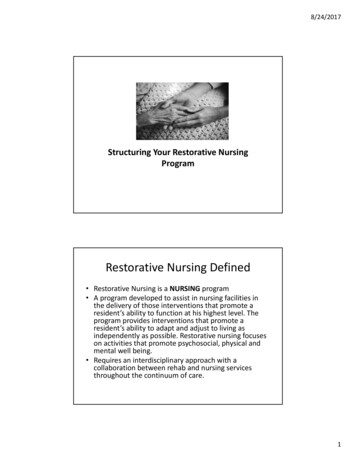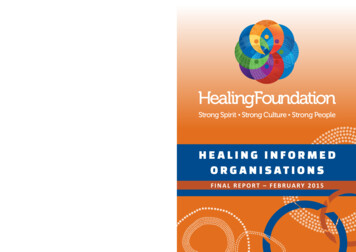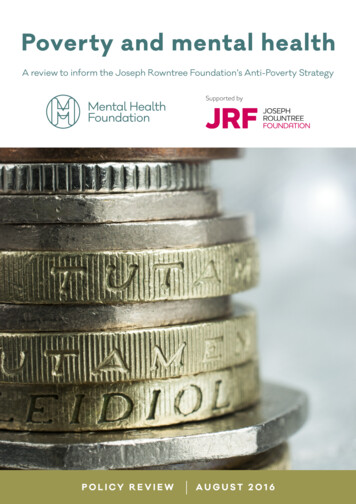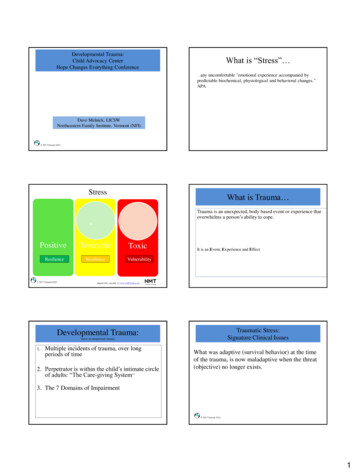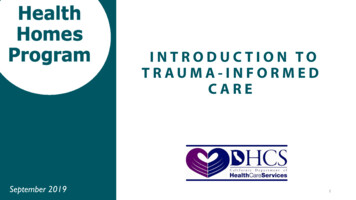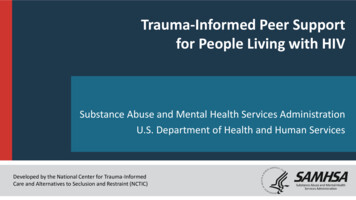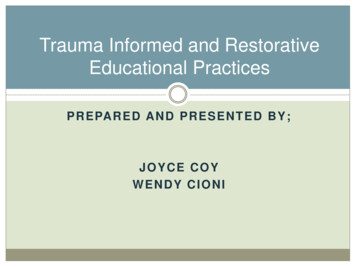
Transcription
Trauma Informed and RestorativeEducational PracticesP R E PA R E D A N D P R E S E N T E D B Y ;JOYCE COYWENDY CIONI
Outline for today What is Trauma?Why should we care about Trauma?Impacts on Brain, Behavior & LearningViewing schools through the lens oftraumaWhat we can doA few more things.
Videohttps://youtu.be/z8vZxDa2KPM
What is trauma? An event that overwhelms an individual’scoping strategies, causing extremeemotional, psychological and physiologicaldistress Traumatic events can be singleoccurrences, recurring events; or multipleunrelated events Repeated exposure can magnify the effecton brain and nervous system development.(www.nctsnet.org)
The impact of a traumatic event depends on:1. Age anddevelopmental stage5. Past experience withtrauma2. Perception of thedanger faced6. Adversities facedfollowing the trauma3. Victim or witness7. Presence/availabilityof adults who canoffer help andprotection4. Relationship to thevictim or perpetrator
Adverse Childhood Experiences Study (ACEs) 10 year study (Kaiser and CDC) 17,000 HMO members (middle class, 72%college educated, 77% white) Link between adverse childhoodexperiences and health/wellness over thelifespan Largest study ever done on this subject
What are Adverse Childhood ExperiencesGrowing up (prior to age 18) in a household with: Physical abuseSexual abuseVerbal abusePhysical neglectEmotional neglect caregiver who’s an alcoholic caregiver who’s a victim ofdomestic violence family member in jail family member diagnosedwith a mental illness disappearance of a parentthrough divorce
The Hidden EpidemicOf the 17,000 HMO Members:64% had an ACE score 1 or more 1 in 4 exposed to 2 categories of ACEs 1 in 12 exposed to 4 categories of ACEs 1 in 4 were sexually abused, physicallyabused or lived in a household withsubstance abuse.
The higher the ACEs score the more likely: Severe and persistent emotional problems Health risk factors Serious social problems Adult disease and disability High health and mental health care costs Poor life expectancy ACE score of 6 or more results in a 20 yeardecrease in life expectancy.
An ACE score of 4 or more 12x more likely to attempt suicide 7x more likely to become alcoholic 4 ½ x more likely to have depression 3x more likely to use IV drugs 2x as likely to smoke Children are 32x more likely to have learning orbehavior problems in school (Nadine Burke Harris)
Primitive or Reptilian Brain Plays a major role in trauma Instinct & survival Formed earliest Breathing, circulation,digestion, startle response Fight, flight, freeze Responds to sensations &body memory Does NOT respond tolanguage and consciousthought
Limbic System Assesses risk negative emotionsExpression & mediationof emotions and feelingsProcessing and storingemotional reactionsMobilized in the face ofthreatFight or Flight
Neocortex Conscious thought & choice makingSelf-awarenessIntegration of feeling,thinking and sensingSeat of executive functionssuch as organizing,inhibition, attentionLast to developMost easily disturbed
Trauma and the Brain Amygdala-The brains emotional computer and alarmsystem.Hippocampus-Brains storage for explicit memories.Stores initial fear memory.Thalamus-Translates sights, sounds, smells into thelanguage of the brainPre-frontal cortex-Where information is used to makedecisions about cognitive and emotional responses.Processes information by cross referencing and makingvarious associations between experiences.
Fight or Flight 1 Information from the senses isreceived by the Thalamus.If based on our past conditioning, memories or temperament thestimuli is recognized as dangerous, the thalamus directs it tothe amygdala, which initiates the fight/flight response.The activated amygdala bypasses the logical mind and triggers abody-wide emergency response within millisecondsImpulses from the amygdala are sent to the hypothalamus toactivate the CNS (heart rate, respiration) and pituitary gland(to secrete hormones which signal other glands to secretestress hormones like epinephrine, norepinephrine, cortisol,etc).
Flight or Fight 2 There are multiple effectson the mind and body. Past conditioning leads tofearful thoughts which lead to feelings of anxiety,anger, worry, panic, etc. The body shuts down digestion and other nonessentialfunctions. Stress hormones act on the brain to form a memory ofthe stressful event. Amygdala tells the brain to make a strong memory ofthe perceived threat.
Freeze An altered state of reality Time slows down Pain/fear awareness diminished May appear calm outside, but not insideThe body or parts of it feel numbVacant eyesInescapable fear can overwhelm biological andpsychological coping mechanismsMay be part of dissociative disorders
Chronic Toxic Stress Children who experience chronic stress live muchof their lives in fight, flight or fright (freeze) modeChildren respond to the world as a place ofconstant danger The brain overloaded with stress hormones doesn’tfunction properly and learning and behavior areaffected Children fall behind in school, fail to develophealthy relationships with peers or havechallenging behavior because they are unable totrust adults
Trauma and the Brain Trauma alters the brainTraumatic experiences trigger a state of arousal in thebody – a heightened state of alertness and fearfulness forone’s safetyShort term and prolonged arousal can effect cognitive andbehavioral functionIn an arousal state, changes in the brain are triggered by avariety of stress related functionsRepeated exposure to a number of traumatic events canmagnify the effect on brain and nervous systemdevelopment.
Brain Effects Hippocampus and amygdala tend to be smaller Lagging Left brain development pleasurableexperiences, decision making & languagedevelopment.More R brain activation perception andexpression of negative emotion.Smaller corpus callosum (R-L connection)Brain stem is dysregulated creating a host ofproblems (such as inattention, arousal level, painsensitivity, .)Real vs imagined danger
Traditional approaches to discipline punish childrenfor behaviors they may not have had the luxury ofdeveloping.Dr. Harry Chugani, Detroit Children’s Hospital
The Adaptive Responses to ThreatThe Alarm StateTrauma throws the system out ofbalance, creates a persisting set ofcompensatory responses that in turncreate a new, but less flexible state ofequilibrium.
Window of “Stress Tolerance”Why are students escalating & disrupting?Healthy reakingpointSpacedifference tillbreakingpointBaseline of stressBaseline of stressHeather T. Forbes
Traumas Effect on LearningAttentionFrequent “downshifting” to survival mode andintrusive memories cause lack of focus.SequencingInconsistency and lack of routines in early yearsmay lead to: Difficulty with sequential ordering Difficulty with multi-step directions or algorithms Impulsivity
Traumas Effect on LearningLanguageLack of talk around ideas, thoughts, feelings maylead to difficulty with: Engaging socially Organizing thoughts Processing thoughtsMemoryChronic stress affects working memory and ability toprocess information accurately
Can Trauma look like ADHD? Hypervigilance and disassociationassociated with Trauma can look like“inattention” Impulsivity might be brought on by a “stressresponse” in overdrive Often difficult to control symptoms withbehavioral therapy and medication
Trauma Exposed Students: Are easily triggered May be disengaged May be disruptive Have a poorattendance Have a downwardslope of failure Seem disconnectedand withdrawn Feel hopeless
These students are living with an insufficient regulatory system, a negative belief system difficulty trusting things will be safe
Toxic Stress and Self-RegulationSelf-regulation: the act of managing one’sthoughts and feelings to engage in goal-directedactions Organizing behavior, controlling impulses, solvingproblems constructively Umbrella term for: executive control, executivefunctioning, self-control, self-management,willpower, grit Related to resilience, coping, stress managementSelf-regulation can be derailed by chronicand toxic stressSelf-Regulation and Toxic Stress Report 4 OPRE Report 2015-97 November 2016
Development of Self-RegulationThese skills increase dramatically during earlychildhood and adolescenceParticular opportunities for intervention Can be strengthened and taught (like literacy) Need support, instruction, reinforcement andcoaching Develops in context of social relationships Dependent of co-regulationSelf-Regulation and Toxic Stress Report 4 OPRE Report 2015-97 November 2016
A negative belief system Heather T. Forbes, “Help for Billy”FeelingtrappedCan’t see beyondcurrent circumstancesHelplessHopeless
A negative belief system develops I’m not lovableI’m not good enoughI’m stupidI screw up every timeI’m worthlessThis is not choiceHeather T. Forbes, “Help for Billy”
“Schools can no longer limitinterventions to individual childrenwith known trauma histories, butmust create instructional frameworksthat integrate a trauma-sensitiveapproach into ALL aspects of theschool day.”Reaching and Teaching Children who Hurt .”, Susan Craig
It starts with anATTITUDE SHIFTLook at students through a TraumaInformed/Restorative lens
In order to be ready to learn,students must feel safe,So that they canstay regulated
Trauma informed School Staffs Understand that causes and effects oftrauma on students Understand the potential to re-traumatizeindividuals IF Interventions and interactions ARENOT sensitive to their experience orneeds Create a culture that builds community
Trauma Informed Schools Foster positive school climate and classroomdesign Build relationships Build social competence Use restorative practices Build resiliency Move toward compassionate discipline
Positive School Climate Create a sense of safety, connection,assurance Staff and students feel valued and part of theschool community Create safe spaces for de-escalation Recognize social skills & academic skills areequally important
Building RelationshipsGreet students at the door Builds connection Touch Use name Make eye contact Smile (TUMS) Allows you to gauge students moodLink at-risk students with supportive staff members who can be: Calm and consistent Firm and accepting Model self regulationSee the individual underneath the behavior Look for the positiveBe curious rather than critical: 10x10
Compassionate Communication(watch tone of voice & body language)Traditional ResponseCompassionate Response “It’s not that difficult” “I need to know how hard “You’re 10 now, learn todeal with life” “You should never haveacted like that” “You need to beresponsible”this is for you” “What is it you need helpwith” Sometimes life just getstoo big, doesn’t it I’m sorry this is so hard“Conscious Discipline”, Becky A. Bailey
Build Social Competence Point out student’s strengths, competencies Help them see themselves as resilient Children are often told what they are doing wrong,rather than what they are doing right Affirmations Catch them being “good” Teach self-regulation skills Validate what have they done well, right, whatworked Give opportunities to help others, teach empathy
Self-Regulation Development Model caregiver co-regulation skills Use social emotional learning curriculum to teachself-regulation skills (Social skills are necessary forcommon core) Mindfulness activities in the classroom Music, yoga, allowing students to move Give child space and time to re-regulate
What Builds Resiliency Close relationships withfamily, friends Seeking help andresources Positive view of yourself,confidence in yourstrengths and abilities Seeing yourself asresilient (not a victim) Coping with stress inhealthy ways Helping others Finding positive meaningin your life despitedifficult events Ability to manage strongfeelings and impulses Good problem-solvingand communication skills Feeling in control
Compassionate Discipline/ Restorative Practices Holds students accountable for misbehavior Seeks to understand the underlying cause ofmisbehavior Has compassion/acknowledges what the studentis going through Understands students who are triggered don’thave control over their behavior in the moment. Student outbursts are a test to pass, not a show ofdisrespect. It’s not personal, it is a cry for help.
De-Escalation Identify triggering events to preventescalation Avoid confrontation by giving choices Use proximity, touch student on the shoulderor eye contact Use calm, quiet voice & model breathing(regulate yourself) Give them time to regulate their emotions
De-Escalation Have a place where student can de-escalateand regulate without fear of punishment(healthy coping)o safe zone in the classroom,o step outside, take a walko Go to office/counseling Talk with student privately once they are calm
De-escalating shifts a student fromsurvival mode:Cannot problem solve with child in fight, flight or freeze!:Let student take time to regroup,give time, take breaths, walkGuarded, but may be able togently talkCalm, ready to process anddiscuss alternative actionsVisual cue card for classroom or administration
Schools can bePlayfulLovingAcceptingCuriousEmpathicWhere everyoneListensUnderstandsValidates
We move from What iswrongwith you?TOWhathappenedto you?
Some hurting kids won't provide you a singlefeel good moment.Until they feel how much you VALUE them Develop a mindset that views misbehavior notas a personal attack but as a language signalingchildren’s neurological state.Discover what is causing the behaviorFind what is getting in the way of your “Behavioris not a choice” mindset.Brook Bouchet
Compassion FatigueSymptoms: Emotional ExhaustionMental/Physical exhaustionReduced sense of personal accomplishment ormeaning in workIsolating selfSelf-Care: Find time for yourself everydayHave a transition from work to homeLearn to say no more often, ask for helpSupport each otherExercise
Last thoughts: Don’t personalize behavior: It's not about us, itis within the child. Recognize your own ACE score and it’simpact Identify your trauma triggers Practice emotional regulation (breath!!) Empathy doesn’t mean taking on the other’semotional process/pain Support one another, you will sink alone.
References Easy to Love, Difficult to Discipline, Dr. Becky BaileyReaching and Teaching Children who Hurt: Strategies for your classroom, Susan Craig 2008”Conscious Discipline, Dr. Becky BaileyHelp for Billy: A Beyond Consequences Approach to Helping Children in the Classroom, byHeather Forbes 2013Building Bonds of Attachment: Awakening Love in Deeply Troubled Children, by Daniel A.HughesHelping Traumatized Children Learn: A Report and Policy Agenda, Massachusetts Advocatesfor ChildrenHelping Traumatized Children Learn: Volume 2: Creating and Advocating for Trauma SensitiveSchools Trauma and Learning Policy Institute“The International Resilience Project: Promoting resilience in children” Edith H. GrotbergThe Heart of Learning and Teaching: Compassion, Resiliency and Academic Success , RayWolpow, PhD, Mona M. Johnson, MA, CPP, CDP, Ron Hertel, BS, Susan O. Kincaid, PhD“Arc Model”, Avis SmithBrooke Bouchet- Beyond Trauma: Building a Resilient Sacramento Conference 2015National Child Traumatic Stress Network (www.nctsnet.org)Regional Child Abuse Prevention Councils gwww.acesconnection.comwww.kidsLINKcares.comBessel van der Kolk, MD Boston UniversityThe Truama Center at Justice Resource Institute: www.traumacenter.orgThe Body Keeps Score, Bessel van der Kolk MDOPRE Report 2015-97, Novemeber 2016, “Self-Regulation and Toxic Stress Report 3, 4”
Thank you for listening!!Feel free to contact either of us at:Wendy Cioni: wcioni@egusd.netJoyce Coy: jcoy@egusd.net
Trauma and the Brain Amygdala-The brains emotional computer and alarm system. Hippocampus-Brains storage for explicit memories. Stores initial fear memory. Thalamus-Translates sights, sounds, smells into the language of the brain Pre-frontal cortex-Where information is used to make decisions about cognitive and emotional responses.


